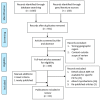Antibiotic Resistance in Pacific Island Countries and Territories: A Systematic Scoping Review
- PMID: 30893880
- PMCID: PMC6466536
- DOI: 10.3390/antibiotics8010029
Antibiotic Resistance in Pacific Island Countries and Territories: A Systematic Scoping Review
Abstract
Several studies have investigated antimicrobial resistance in low- and middle-income countries, but to date little attention has been paid to the Pacific Islands Countries and Territories (PICTs). This study aims to review the literature on antibiotic resistance (ABR) in healthcare settings in PICTs to inform further research and future policy development for the region. Following the PRISMA-ScR checklist health databases and grey literature sources were searched. Three reviewers independently screened the literature for inclusion, data was extracted using a charting tool and the results were described and synthesised. Sixty-five studies about ABR in PICTs were identified and these are primarily about New Caledonia, Fiji and Papua New Guinea. Ten PICTs contributed the remaining 21 studies and nine PICTs were not represented. The predominant gram-positive pathogen reported was community-acquired methicillin resistant S. aureus and the rates of resistance ranged widely (>50% to <20%). Resistance reported in gram-negative pathogens was mainly associated with healthcare-associated infections (HCAIs). Extended spectrum beta-lactamase (ESBL) producing K. pneumoniae isolates were reported in New Caledonia (3.4%) and Fiji (22%) and carbapenem resistant A. baumannii (CR-ab) isolates in the French Territories (24.8%). ABR is a problem in the PICTs, but the epidemiology requires further characterisation. Action on strengthening surveillance in PICTs needs to be prioritised so strategies to contain ABR can be fully realised.
Keywords: antimicrobial resistance; gram-negative organisms; gram-positive organisms; healthcare associated infections; surveillance.
Conflict of interest statement
The authors declare no conflict of interest.
Figures
Similar articles
-
Cancer epidemiology in the small nations of Pacific Islands.Cancer Epidemiol. 2017 Oct;50(Pt B):184-192. doi: 10.1016/j.canep.2017.09.002. Cancer Epidemiol. 2017. PMID: 29120824
-
The impact of national policies on animal disease reporting within selected Pacific Island Countries and Territories (PICTs).Trop Anim Health Prod. 2018 Oct;50(7):1547-1558. doi: 10.1007/s11250-018-1594-7. Epub 2018 Apr 20. Trop Anim Health Prod. 2018. PMID: 29679359
-
Review of scientific research on air quality and environmental health risk and impact for PICTS.Sci Total Environ. 2024 Sep 10;942:173628. doi: 10.1016/j.scitotenv.2024.173628. Epub 2024 Jun 5. Sci Total Environ. 2024. PMID: 38848924
-
Baseline evaluation of the World Health Organization (WHO) infection prevention and control (IPC) core components in Pacific Island Countries and Territories (PICTs).Antimicrob Resist Infect Control. 2024 Sep 27;13(1):108. doi: 10.1186/s13756-024-01447-9. Antimicrob Resist Infect Control. 2024. PMID: 39334478 Free PMC article.
-
The interface between COVID-19 and bacterial healthcare-associated infections.Clin Microbiol Infect. 2021 Dec;27(12):1772-1776. doi: 10.1016/j.cmi.2021.06.001. Epub 2021 Jun 7. Clin Microbiol Infect. 2021. PMID: 34111586 Free PMC article. Review.
Cited by
-
Ertapenem Supplemented Selective Media as a New Strategy to Distinguish β-Lactam-Resistant Enterobacterales: Application to Clinical and Wastewater Samples.Antibiotics (Basel). 2023 Feb 15;12(2):392. doi: 10.3390/antibiotics12020392. Antibiotics (Basel). 2023. PMID: 36830303 Free PMC article.
-
Antimicrobial resistance in the Pacific Island countries and territories.BMJ Glob Health. 2020 Apr;5(4):e002418. doi: 10.1136/bmjgh-2020-002418. BMJ Glob Health. 2020. PMID: 32349993 Free PMC article. Review.
-
Bacteriology and Antimicrobial Resistance in Vanuatu: January 2017 to December 2019.Antibiotics (Basel). 2020 Mar 31;9(4):151. doi: 10.3390/antibiotics9040151. Antibiotics (Basel). 2020. PMID: 32244420 Free PMC article.
-
Antimicrobial susceptibility of bacterial isolates from clinical specimens in four Pacific Island countries, 2017-2021.Lancet Reg Health West Pac. 2023 Feb 2;32:100677. doi: 10.1016/j.lanwpc.2022.100677. eCollection 2023 Mar. Lancet Reg Health West Pac. 2023. PMID: 36798514 Free PMC article.
-
Gram-negative neonatal sepsis in low- and lower-middle-income countries and WHO empirical antibiotic recommendations: A systematic review and meta-analysis.PLoS Med. 2021 Sep 28;18(9):e1003787. doi: 10.1371/journal.pmed.1003787. eCollection 2021 Sep. PLoS Med. 2021. PMID: 34582466 Free PMC article.
References
-
- Cecchini M., Langer J. Antimicrobial Resistance in G7 Countries and beyond: Economic Issues, Policies and Options for Action. OECD; Paris, France: 2015. [(accessed on 1 July 2018)]. Available online: https://www.oecd.org/els/health-systems/Antimicrobial-Resistance-in-G7-C....
-
- The Review on Antimicrobial Resistance. [(accessed on 7 July 2018)]; Available online: https://amr-review.org/sites/default/files/160525_Final%20paper_with%20c....
-
- A Primer for Media: Antimicrobial Resistance in the Western Pacific. [(accessed on 8 July 2018)]; Available online: http://iris.wpro.who.int/handle/10665.1/13087.
-
- National Action Plan for Global Change on Antimicrobial Resistance. [(accessed on 1 May 2018)]; Available online: http://iris.wpro.who.int/handle/10665.1/13066.
Publication types
Grants and funding
LinkOut - more resources
Full Text Sources


